-
Publish Your Research/Review Articles in our High Quality Journal for just USD $99*+Taxes( *T&C Apply)
Offer Ends On
Williams Pinto Marques Ferreira*, Humberto Paiva Fonseca, Edgard Augusto de Toledo Picoli and José Luis Rufino
Corresponding Author: Williams Pinto Marques Ferreira, Brazilian Enterprise for Agricultural Research, National Center for Research on Coffee, Brasília-DF, 70770-901, Brazil
Received: August 12, 2025 ; Revised: September 08, 2025 ; Accepted: September 11, 2025 ; Available Online: September 26, 2025
Citation: Ferreira WPM, Fonseca HP, de Toledo Picoli EA & Rufino JL. (2025) Environmental Determinant of Specialty Coffee Excellence: Analyzing Climatic Impacts in a Brazilian Coffee-Growing Region. J Agric For Meterol Stud, 4(1): 1-11.
Copyrights: ©2025 Ferreira WPM, Fonseca HP, de Toledo Picoli EA & Rufino JL. This is an open-access article distributed under the terms of the Creative Commons Attribution License, which permits unrestricted use, distribution, and reproduction in any medium, provided the original author and source are credited.
Views & Citations
Likes & Shares
This study investigates the influence of environmental factors, particularly climate and altitude, on the sensory quality of high-grade coffee in the Mates de Minas region. The objective was to understand how climatic and edaphoclimatic variables affect the beverage’s sensory attributes, contributing to sustainable agricultural strategies. Coffee samples from 26 municipalities were analyzed, totaling 367 georeferenced points. Historical climatic data from 1960 to 2014 and topographic variables were integrated with sensory evaluations conducted by certified tasters according to the standards of the Brazilian Specialty Coffee Association. Statistical models, including Principal Component Analysis and Multiple Linear Regression, were applied to correlate environmental factors with coffee quality. The results indicated low variation in sensory attributes, ensuring consistency in quality. Flavor, aftertaste, and sweetness were the most influential attributes in determining the final score. Among all municipalities, Arizona stood out for producing the highest-quality coffees, likely due to its high altitude and thermal regulation. This study confirms that altitude and temperature during fruit maturation are key determinants of coffee quality. The integration of climatic and geospatial data enables more efficient agricultural strategies, fostering the sustainable production of specialty coffees.
Keywords: Coffeaarabica, Climatic factors and elements, Agricultural sustainability, Geographical factors
INTRODUCTION
Coffee remains one of the most widely consumed beverages globally, with production reaching 168.2 million bags in 2022/23, marking as light increase of 0.1%. Brazil, the world’s largest coffee producer, harvested 55 million bags [1], reaffirming its dominance in the global market. Within Brazil, Minas Gerais plays a crucial role, accounting for approximately 8.5% of global coffee production. This state's developments have far-reaching implications for the international coffee industry.
Small holder farmers, who rely on coffee cultivation for their livelihoods, collectively represent the backbone of global production. Beyond its economic significance, coffee holds increasing social and environmental relevance, driven by rising global demand for specialty and sustainably sourced coffee. Consumers seek high-quality coffee experiences, leading to innovations in brewing methods and farming practices that emphasize sustainability, ethical sourcing, and fair compensation for producers.
The Matas de Minas region stands out for its production of specialty Arabica coffee, a variety prized for its superior flavor and market value. Recognized under Brazil’s Geographic Indication (GI) system, Matas de Minas exemplifies how terroir-defined by specific climatic and environmental conditions-shapes the sensory attributes of coffee. Key climatic variables, including water deficit, Palmer Drought Severity Index, altitude, solar radiation, and precipitation patterns, play a decisive role in coffee quality. Understanding these factors is essential for optimizing production and maintaining Brazil’s leadership in the global specialty coffee market.
Climate change poses significant challenges to coffee production, affecting yield, flavor profiles, and long-term sustainability. Given this context, this study aims to evaluate the influence of environmental factors, particularly climate and altitude, on the sensory attributes and quality of coffee from Matas de Minas. By analyzing these relationships, the researchprovidesinsightsthatcaninformsustainableagriculturalpractices, support adaptation strategies, and enhance the resilience of coffee-growing regions facing increasing climatic variability.
MATERIALS AND METHODS
This study was conducted in the Mates de Minas region, located within the Atlantic Forest biome in eastern Minas Gerais, Brazil. The region is characterized by rugged terrain, with elevations ranging from 251 m (Muriaé) to 2,295 m (Alto Caparaó) (Figure 1). This altitudinal gradient directly influences local climatic conditions, affecting both coffee production and quality. The map in Figure 1 illustrates the elevation variation across the study area.
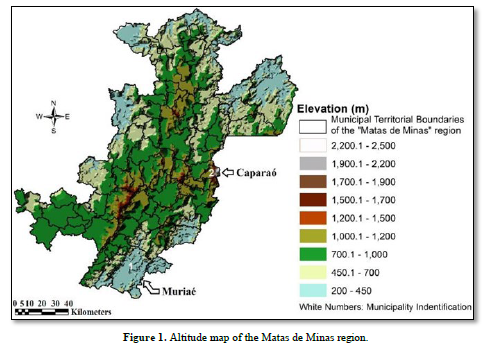
At the sampling sites, key environmental variables were analyzed, including coffee variety, altitude, and slope orientation, to assess their influence on coffee quality. Figure 2 presents the region’s climatic conditions, highlighting annual maximum, minimum, and mean temperatures. Climatic data were sourced from the TerraClimate database, covering the period from 1960 to 2014, providing a robust historical assessment of the environmental conditions impacting coffee production.
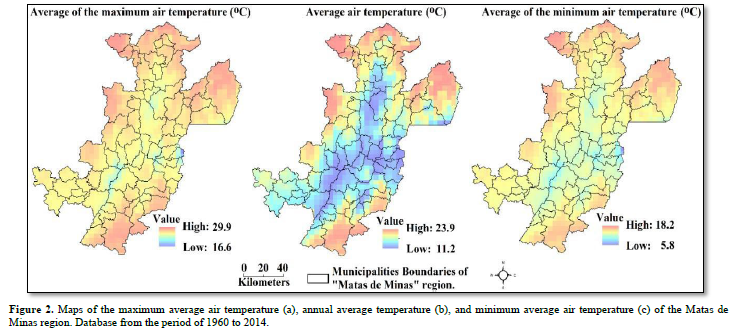 During harvest, approximately 30 plants per hectare were selected, and cherries were manually picked from four branches of each plant-two from each side-to ensure representativeness. These cherries were then combined to create composite samples at each collection point. A total of five liters (5L, approximately 3kg) of coffee cherries were collected from 367 georeferenced locations across coffee farms in 26 municipalities (Figure 3), ensuring the harvest of fruits at their optimal ripening stage. The selected coffee varieties-Red Catuai 44 and Yellow Catuai 162-are the most widely cultivated in the region. This sampling methodology ensured a comprehensive representation of the collected coffee.
During harvest, approximately 30 plants per hectare were selected, and cherries were manually picked from four branches of each plant-two from each side-to ensure representativeness. These cherries were then combined to create composite samples at each collection point. A total of five liters (5L, approximately 3kg) of coffee cherries were collected from 367 georeferenced locations across coffee farms in 26 municipalities (Figure 3), ensuring the harvest of fruits at their optimal ripening stage. The selected coffee varieties-Red Catuai 44 and Yellow Catuai 162-are the most widely cultivated in the region. This sampling methodology ensured a comprehensive representation of the collected coffee.
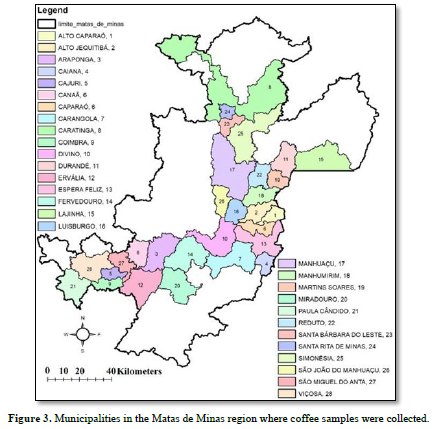
The sampling locations were precisely georeferenced using the Global Navigation Satellite System, with a margin of error of upto 10 meters. This approach enabled the detailed integration of regional climatic data from the central pixels of the TerraClimate dataset, allowing for a more robust analysis of the environmental conditions influencing coffee quality. Accurate geolocation also facilitated a better interpretation of the relationship between environmental factors and the sensory attributes of the coffee beans.
Only ripe cherries were harvested to assess coffee sensory quality, ensuring a representative analysis of the region’s qualitative potential. Unripe and overripe cherries were discarded, as they can compromise beverage uniformity and sensory profile. After harvesting, the beans were washed, manually pulped, and the mucilage was retained on the parchment. They were then artificially dried in a gas dryer at 40° C until they reached approximately 12% moisture content, as specified for the experiment. Fruit moisture content was measured using a Gehaka G800 digital moisture meter. After drying, the samples were processed and stored in plastic containers in a BOD chamber (Biochemical Oxygen Demand) for approximately two months before being subjected to physical and sensory quality tests. The roasting process was standardized to a medium-light roast, with an Agtron disc color rating of 65, in accordance with the Agtron/SCAA (Specialty Coffee Association of America) system [2]. This step is critical for preserving the beans' quality and ensuring a homogeneous lot for sensory analysis.
Three independent tasters, all certified Q-graders, evaluated the coffee samples from the Matas de Minas region, scoring them according to eight sensory attributes. According to the Brazilian Specialty Coffee Association (BSCA) methodology, coffees with scores below 80 are not classified, indicating the absence of distinctive flavors or the presence of defects. The evaluation adhered to the guidelines set by the BSCA. The sensory attributes evaluated were: 1) clean cup, free of negative impressions; 2) balance, referring to the harmony of sensory attributes; 3) body, the tactile perception of the beverage's "density"; 4) flavor, which varies according to the bean variety and preparation method; 5) sweetness, associated with natural carbohydrates; 6) acidity, which, when pleasant, contributes to complexity; 7) aftertaste, the flavors that persist after ingestion; and 8) overall score, representing the harmony among attributes.
To ensure methodological rigor and strengthen the analysis of environmental influences on coffee quality, precise georeferencing was employed to integrate regional climatic data with sensory evaluations. The data were collected in the Matas de Minas region between April and July 2016, corresponding to the 2017 harvest season. This temporal alignment is critical, as environmental conditions during the growing and maturation phases directly affect the chemical composition and sensory attributes of the beans. By linking high-resolution geospatial data with standardized sensory assessments, this study provides a comprehensive framework for understanding the complex interactions between terroir and coffee quality. This facilitated a robust and accurate analysis of the environmental conditions directly impacting coffee crop development. Data integration and geoprocessing were performed using Arc GIS10.3 and SNAP6.3, enhancing methodological accuracy. This approach, combining precise geographic location with detailed historical climate data, represents a significant innovation in studying environmental factors affecting agricultural crops, broadening the applicability of this research to other biomes and agricultural regions worldwide.
Aligning the collection points with reanalyzed TerraClimate data ensured the accuracy of the analysis of climatic conditions. These points captured the climatic nuances of the region. Data from Abatzoglou [3] covered an area of approximately four-square kilometers, spanning from 1958 to 2017, and were obtained in matrix format from the TerraClimate database.
The Matas de Minas region is defined by a complex interaction of physical, biological, and climatic factors that influence the phenological phases of coffee, impacting plant development from planting to harvest. Two water stress indices and other climatic elements (Table 1) were considered during the second harvest year, which began in September and ended in the following September, encompassing the flowering, fruit filling, and maturation phases.

The influence of different coffee phenological phases was examined, with each phase being associated with specific climatic conditions (Table 2).

The influence of three groups of environmental variables was evaluated: (a) Climatic Factors-altitude, latitude, and slope orientation relative to the sun (Table 3); (b) Climatic Elements-PPT, SRAD, TMAX, and TMIN; and (c) Water Deficit Indices-DEF and PAL (Table 1), all related to the coffee phenological cycle (Table 2).
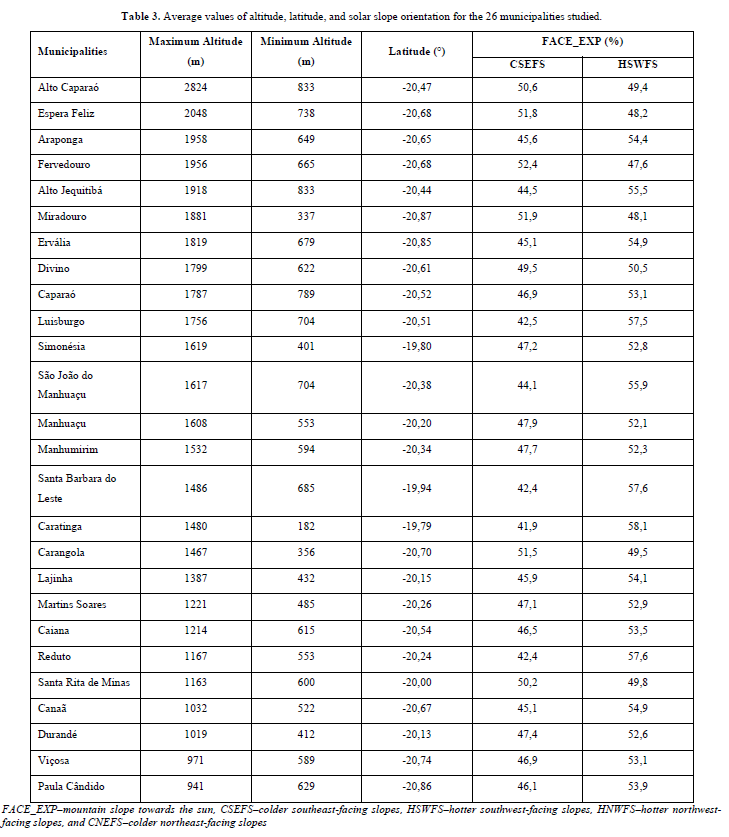
Certified Q-graders evaluated the coffee samples, and the sensory scores were correlated with environmental factors such as altitude, soil type, and cultivation practices. Descriptive statistics provided initial insights into the eight primary flavor attributes. A Principal Component Analysis (PCA) was then performed to identify the most influential variables, followed by Multiple Linear Regression (MLR) to establish the relationships between climatic conditions and final coffee quality.
Correlation analysis explored potential relationships between flavor attributes and the final coffee score. Principal Component Analysis (PCA) was employed to identify the most relevant attributes influencing the final coffee quality, providing a clear visualization of variable correlations through a biplot. This approach was chosen due to its ability to reduce data dimensionality and facilitate the identification of underlying patterns. Subsequently, Multiple Linear Regression (MLR) was applied to establish quantitative relationships between climatic factors and the final coffee score, ensuring a robust statistical analysis. Data normalization to zero mean and unit variance preceded the PCA, which was based on a (pxp) matrix, where p = 81, representing the maximum number of possible combinations. This matrix served as the basis for analyzing orthogonal variables, using R software.
Jolliffe's [4] Criterion was applied to select principal components with variance greater than 0.7 (λ≥0.7). Multiple Linear Regression (MLR -Equation 1) was applied using the stepwise method, which enables the automated selection of the most relevant variables explaining the final coffee quality (GRADE). Only variables with statistically significant influence (P≤0.1) were retained. Model adequacy was assessed through the adjusted coefficient of determination (adjusted R²) and the residual standard error, ensuring the reliability of the results.

Where y = coffee score (dependent variable); x₁ = slope orientation to the sun; x₂ = latitude; x₃ = altitude; and, respectively, radiation, water deficit, Palmer Drought Severity Index (PDSI), precipitation, and maximum and minimum temperatures during the flowering, fruit filling, and maturation phases (independent variables). The coefficients β₀, β₁, ..., β₂₁ represent the intercept and the effect size of each environmental variable on the coffee score, quantifying how much the coffee quality changes with a unit variation in each factor. The term ε denotes the residual error, accounting for the variation in coffee quality not explained by the model. Only variables with statistically significant coefficients (P ≤ 0.1) were retained, ensuring that the selected factors meaningfully influence the final coffee quality (GRADE).
RESULTS AND DISCUSSION
The following results present a comprehensive analysis of coffee quality in the Matas de Minas region, encompassing 26 evaluated municipalities. The assessment of sensory attributes provides insight into the key determinants of beverage quality, allowing for a precise characterization of the distinctive attributes of the beans cultivated in this region.
The descriptive analysis of sensory attributes reveals a consistent sensory profile across the samples, as evidenced by a coefficient of variation (CV%) below 12% for all attributes-indicating low dispersion and high sensory stability (Table 4). Such uniformity is essential for ensuring consumer loyalty and maintaining the predictability of product quality, reinforcing the market positioning of specialty coffee from this region.
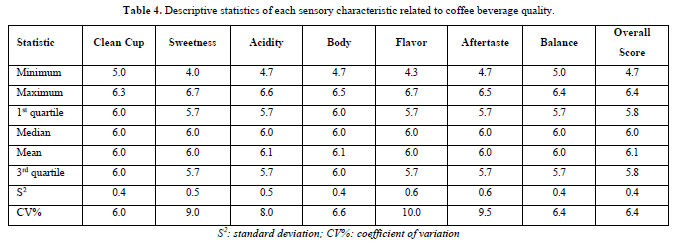
The attributes Clean Cup and Sweetness exhibited high median values (6.0), reinforcing the perception of superior beverage equality. Even minor variations in these attributes can substantially influence the sensory experience, directly.
Affecting the overall appreciation of the coffee. Previous studies [5,6] have demonstrated that maintaining consistency in these parameters is essential for ensuring consumer satisfaction and strengthening the market positioning of specialty coffee.
The correlation matrix of sensory attributes (Figure 4) reveals that Flavor (0.91), Aftertaste, and Sweetness (0.90) exhibit the strongest correlation with the overall score, underscoring their significance in the final evaluation of the beverage. In contrast, attributes such as Clean Cup, Body, and Balance showed a lower impact on the final score, aligning with the findings of Perez-Molina [7] for samples collected at varying altitudes within the same region.
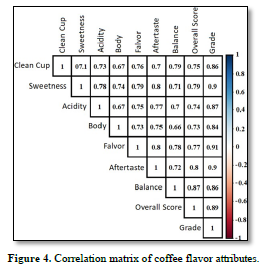
The sensory quality of coffee arises from the interplay of biochemical factors [8], environmental conditions [9-11], and the plant’s vegetative attributes. Terroir components, including soil composition, altitude, and climatic variations, play a fundamental role in defining the coffee’s sensory profile and the development of distinctive aromatic notes.
Principal Component Analysis (PCA) was applied to the sensory dataset to reduce dimensionality while preserving the most informative variables for coffee characterization. The first two principal components (PC1 and PC2) explained 85.4% of the total variance (Table 5), demonstrating the technique’s effectiveness in capturing the primary sensory attributes that define coffee quality.

PC1, which accounts for 79.9% of the total variance, is strongly associated with Flavor, Aftertaste, Balance, Clean Cup, and Sweetness, serving as the primary discriminator of high-quality samples. PC2, which explains 5.5% of the variance, differentiates samples based on Acidity and Body, indicating that these attributes provide a complementary influence on sensory perception (Figure 5).
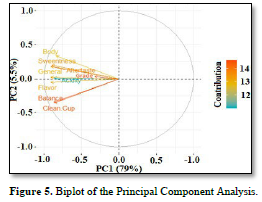
The application of Principal Component Analysis -(PCA) enables a more precise interpretation of the inter relationships between sensory attributes and beverage quality, facilitating the identification of key factors that define the sensory excellence of coffee produced in the region. Moreover, the reproducibility of these results across different coffee-producing areas supports the adoption of a standardized approach to specialty coffee characterization.
The convergence between PCA and the correlation matrix confirms that Flavor, Aftertaste, Sweetness, Balance, and Overall Score are the primary determinants in distinguishing and enhancing the value of specialty coffees from the Matas de Minas region. These findings can be extended to other coffee-producing regions, contributing to a standardized methodology for evaluating sensory quality.
The sensory quality of coffee in the Matas de Minas region is largely shaped by environmental variables, including precipitation, solar radiation, water deficit, and air temperature [8-10]. These climatic factors exert a direct influence on key sensory attributes-particularly Flavor, Aftertaste, and Sweetness-which exhibit the strongest correlations with the overall sensory score.
Figure 6 presents the sensory profile of the average flavor attributes for each locality analyzed within the region, highlighting variations across municipalities. Each graph illustrates the distribution of sensory attributes, including Clean Cup, Sweetness, Flavor, Aftertaste, Acidity, Body, Balance, and Overall Score, allowing for a comprehensive visualization of differences and the identification of distinct sensory patterns. This analysis underscores the influence of environmental factors and local agricultural practices on the complexity and harmony of coffee, aiding in the identification of regions with superior sensory balance and quality.
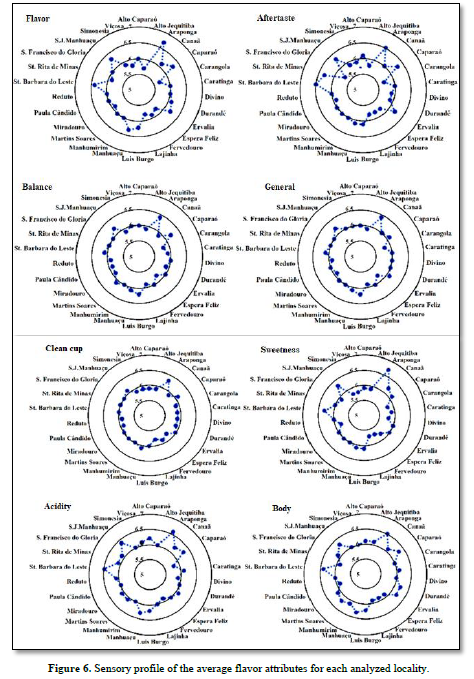
The attribute scores in each graph cluster around 6, reflecting Q-grade revaluations adjusted using a calculation method that aligns the sum of sensory attributes with the 0-100 scale established by the Specialty Coffee Association (SCA).
The Clean Cup attribute exhibited the highest degree of homogeneity across the evaluated localities, with average scores around 6. As illustrated in Figure 6, Araponga stands out with flavor attribute values exceeding 6.3, whereas Caratinga presents values equal to or below 6. This differentiation suggests that, due to the sensory balance among the analyzed attributes, the coffee produced in Araponga is of superior quality compared to Caratinga and other municipalities in the region.
Araponga's sensory prominence can be attributed to its favorable edaphoclimatic conditions, including adequate precipitation, altitudes ranging from 750 to 1,250 meters, and the presence of orographic clouds that contribute to thermal regulation. Additionally, the Serra do Brigadeiro Servesasa natural barrier against strong winds and extreme temperature fluctuations, fostering an optimal microclimate for high-quality coffee production. These factors collectively explain the observed sensory superiority of Araponga in comparison to Caratinga and other localities within the region.
The spatial distribution of sensory attributes exhibits substantial variability across the studied municipalities. As depicted in Figure 7, coffee sensory scores vary considerably among the 26 municipalities of the Matas de Minas region, reflecting distinct environmental influences on product quality. The legend in Figure 7 (ranging from 6.0 to 7.2) corresponds to Q-grader scores, as previously detailed in Figure 6, reinforcing the observed heterogeneity in sensory performance across different localities.
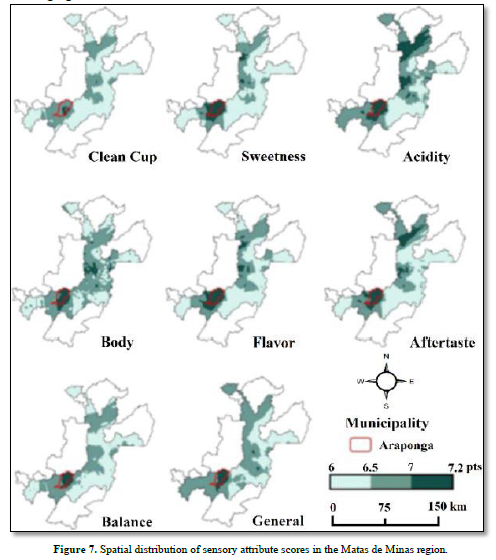
Certain areas consistently register high scores, while others exhibit lower average values. These variations primarily reflect the influence of environmental factors, such as altitude and temperature, in conjunction with the agricultural practices employed. Sensory mapping thus emerges as a fundamental tool for identifying regions with greater productive potential and guiding targeted strategies to enhance coffee quality across the region.
The observed sensory scores are intrinsically linked to the region’s environmental conditions. Optimal altitudes, fertile soils, and favorable climatic factors collectively contribute to the production of high-quality coffees. In contrast, areas with lower sensory scores may experience environmental constraints or less efficient management practices, leading to a decline in coffee quality.
The correlation between sensory quality and environmental factors is further supported by the altitudinal distribution (Figure 1) and annual mean temperatures (Figure 2). Municipalities situated at higher elevations with moderate temperatures consistently produced superior-quality coffees, reinforcing their strategic importance for specialty coffee cultivation.
As shown in Figure 7, Araponga consistently achieves scores exceeding 6.5 across all evaluated attributes, whereas Caratinga presents lower average values. This heterogeneity underscores the influence of both environmental conditions and agricultural practices on coffee quality.
Sensory mapping serves as a critical tool for identifying regions with greater productive potential, facilitating the adoption of more efficient agricultural strategies and fostering the sustainable development of local coffee farming. By highlighting the specialty coffee potential of the Matas de Minas region, this spatial analysis plays a fundamental role in enhancing product quality. These insights enable producers to refine cultivation and processing techniques, ensuring consistency in desirable sensory attributes and maximizing the added value of their coffee in the global market.
CONCLUSIONS
This study demonstrates that a Coefficient of Variation (CV%) below 12% for all flavor attributes signifies stable and consistent sensory characteristics among coffee beans, a critical factor in ensuring a high-quality sensory experience for consumers. The high median scores in key attributes such as Clean Cup and Sweetness underscore the superior quality of coffee produced in the region, where even minor variations can have substantial effects on consumer perception and market value. Moreover, the methodologies and analytical approaches presented here in extend beyond the Matas de Minas region, enabling producers in diverse contexts to assess and enhance coffee quality based on specific sensory attributes.
Among the water stress indices analyzed, the Water Deficit Index (DEF) significantly influenced only the clean cup attribute, whereas the Palmer Drought Severity Index (PDSI) exhibited a stronger impact on aftertaste and the overall flavor profile. In the Matas de Minas region, the most critical climatic variables for high-quality coffee production were the maximum air temperature during fruit ripening and precipitation levels during the bean-set and ripening phases. Additionally, geographical factors such as altitude and slope orientation relative to solar exposure played a crucial role, with altitude emerging as the most influential determinant of coffee quality.
The clean cup attribute exhibited the highest homogeneity and the lowest mean scores across the evaluated localities, suggesting its relatively minor contribution to the overall coffee quality in the region. In contrast, flavor and after taste emerged as the primary determinants of final coffee quality in Matas de Minas. Among the assessed localities, Araponga demonstrated the highest coffee quality, while Caratinga recorded the lowest.
All environmental variables analyzed were essential for a comprehensive understanding of the sensory characteristics influencing high-quality coffee production in the Matas de Minas region. Beyond these direct findings, this study underscores the importance of integrating georeferencing technologies and detailed climate analyses into agricultural research. The application of these advanced tools has facilitated a deeper understanding of the climatic and environmental factors affecting coffee phenology, generating insights with global applicability. By providing a framework for accurately assessing the interactions between climate and agriculture, this research contributes to the development of mitigation and adaptation strategies, particularly in the context of climate change, thereby enhancing the resilience of vulnerable crops such as coffee in various growing regions.
The findings of this study highlight the significant influence of environmental factors-particularly climate variability and altitude-on the sensory attributes and overall quality of coffee produced in the Matas de Minas region. Higher altitudes were consistently associated with superior flavor profiles, reinforcing the suitability of these areas for high-quality coffee production. Furthermore, climatic conditions, including temperature fluctuations and rainfall patterns, were shown to affect bean flavor and aroma, emphasizing the importance of microclimate management in optimizing coffee production.
These insights provide valuable guidance for coffee producers and stakeholders, offering practical recommendations for prioritizing altitude management and adapting to evolving climatic conditions. Future research should investigate the long-term effects of climate change on coffee quality and explore additional environmental variables that may influence sensory characteristics. By advancing knowledge in this field, producers in the Matas de Minas region can continue refining their cultivation practices and upholding the high standards of coffee quality for which the region is renowned.
ACKNOWLEDGMENTS
This research was conducted in partnership with the Brazilian Agricultural Research Corporation - National Coffee Research Center (EMBRAPA Coffee), which provided financial support. We would like to thank the Federal University of Viçosa (UFV) and the Agricultural Research Company of Minas Gerais (EPAMIG) for their contributions, including personnel involvement and academic support from faculty members. Additionally, we acknowledge the Brazilian Micro and Small Business Support Service (SEBRAE/MG) for providing additional resources that were essential to the success of this research. We are also grateful to the Brazilian Coffee Research and Development Consortium (CBP&D/Café - 02.13.02.005.00.00) and the Research Support Foundation of the State of Minas Gerais (FAPEMIG -APQ-01723-21) for their financial assistance in conducting this study.
No Files Found
Share Your Publication :